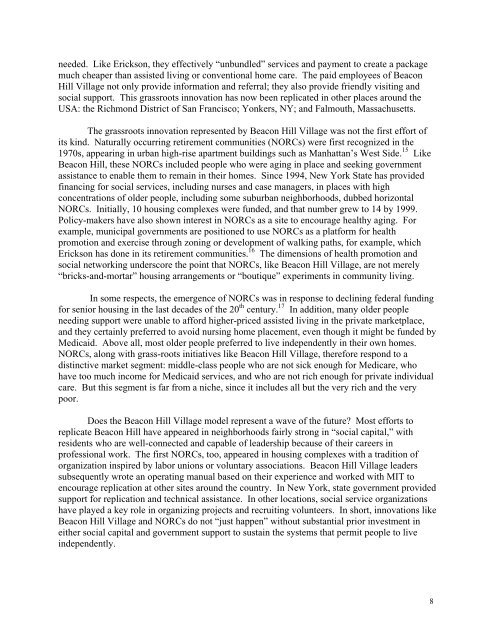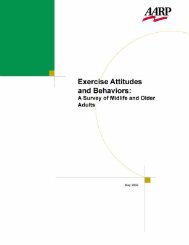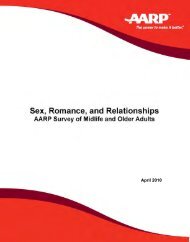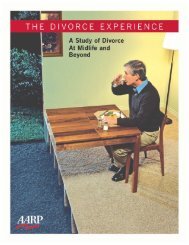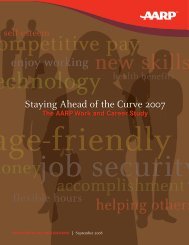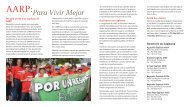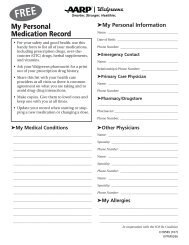The New Aging Enterprise - aarp
The New Aging Enterprise - aarp
The New Aging Enterprise - aarp
Create successful ePaper yourself
Turn your PDF publications into a flip-book with our unique Google optimized e-Paper software.
needed. Like Erickson, they effectively “unbundled” services and payment to create a package<br />
much cheaper than assisted living or conventional home care. <strong>The</strong> paid employees of Beacon<br />
Hill Village not only provide information and referral; they also provide friendly visiting and<br />
social support. This grassroots innovation has now been replicated in other places around the<br />
USA: the Richmond District of San Francisco; Yonkers, NY; and Falmouth, Massachusetts.<br />
<strong>The</strong> grassroots innovation represented by Beacon Hill Village was not the first effort of<br />
its kind. Naturally occurring retirement communities (NORCs) were first recognized in the<br />
1970s, appearing in urban high-rise apartment buildings such as Manhattan’s West Side. 15 Like<br />
Beacon Hill, these NORCs included people who were aging in place and seeking government<br />
assistance to enable them to remain in their homes. Since 1994, <strong>New</strong> York State has provided<br />
financing for social services, including nurses and case managers, in places with high<br />
concentrations of older people, including some suburban neighborhoods, dubbed horizontal<br />
NORCs. Initially, 10 housing complexes were funded, and that number grew to 14 by 1999.<br />
Policy-makers have also shown interest in NORCs as a site to encourage healthy aging. For<br />
example, municipal governments are positioned to use NORCs as a platform for health<br />
promotion and exercise through zoning or development of walking paths, for example, which<br />
Erickson has done in its retirement communities. 16 <strong>The</strong> dimensions of health promotion and<br />
social networking underscore the point that NORCs, like Beacon Hill Village, are not merely<br />
“bricks-and-mortar” housing arrangements or “boutique” experiments in community living.<br />
In some respects, the emergence of NORCs was in response to declining federal funding<br />
for senior housing in the last decades of the 20 th century. 17 In addition, many older people<br />
needing support were unable to afford higher-priced assisted living in the private marketplace,<br />
and they certainly preferred to avoid nursing home placement, even though it might be funded by<br />
Medicaid. Above all, most older people preferred to live independently in their own homes.<br />
NORCs, along with grass-roots initiatives like Beacon Hill Village, therefore respond to a<br />
distinctive market segment: middle-class people who are not sick enough for Medicare, who<br />
have too much income for Medicaid services, and who are not rich enough for private individual<br />
care. But this segment is far from a niche, since it includes all but the very rich and the very<br />
poor.<br />
Does the Beacon Hill Village model represent a wave of the future? Most efforts to<br />
replicate Beacon Hill have appeared in neighborhoods fairly strong in “social capital,” with<br />
residents who are well-connected and capable of leadership because of their careers in<br />
professional work. <strong>The</strong> first NORCs, too, appeared in housing complexes with a tradition of<br />
organization inspired by labor unions or voluntary associations. Beacon Hill Village leaders<br />
subsequently wrote an operating manual based on their experience and worked with MIT to<br />
encourage replication at other sites around the country. In <strong>New</strong> York, state government provided<br />
support for replication and technical assistance. In other locations, social service organizations<br />
have played a key role in organizing projects and recruiting volunteers. In short, innovations like<br />
Beacon Hill Village and NORCs do not “just happen” without substantial prior investment in<br />
either social capital and government support to sustain the systems that permit people to live<br />
independently.<br />
8


